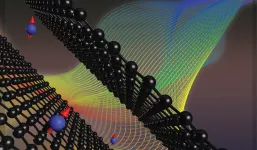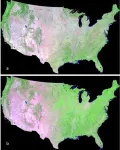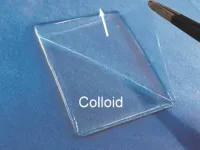(Press-News.org) PROVIDENCE, R.I. [Brown University] — For two decades, physicists have tried to directly manipulate the spin of electrons in 2D materials like graphene. Doing so could spark key advances in the burgeoning world of 2D electronics, a field where super-fast, small and flexible electronic devices carry out computations based on quantum mechanics.
Standing in the way is that the typical way in which scientists measure the spin of electrons — an essential behavior that gives everything in the physical universe its structure — usually doesn’t work in 2D materials. This makes it incredibly difficult to fully understand the materials and propel forward technological advances based on them. But a team of scientists led by Brown University researchers believe they now have a way around this longstanding challenge. They describe their solution in a new study published in Nature Physics.
In the study, the team — which also include scientists from the Center for Integrated Nanotechnologies at Sandia National Laboratories, and the University of Innsbruck — describe what they believe to be the first measurement showing direct interaction between electrons spinning in a 2D material and photons coming from microwave radiation. Called a coupling, the absorption of microwave photons by electrons establishes a novel experimental technique for directly studying the properties of how electrons spin in these 2D quantum materials — one that could serve as a foundation for developing computational and communicational technologies based on those materials, according to the researchers.
“Spin structure is the most important part of a quantum phenomenon, but we’ve never really had a direct probe for it in these 2D materials,” said Jia Li, an assistant professor of physics at Brown and senior author of the research. “That challenge has prevented us from theoretically studying spin in these fascinating material for the last two decades. We can now use this method to study a lot of different systems that we could not study before.”
The researchers made the measurements on a relatively new 2D material called “magic-angle” twisted bilayer graphene. This graphene-based material is created when two sheets of ultrathin layers of carbon are stacked and twisted to just the right angle, converting the new double-layered structure into a superconductor that allows electricity to flow without resistance or energy waste. Just discovered in 2018, the researchers focused on the material because of the potential and mystery surrounding it.
“A lot of the major questions that were posed in 2018 have still yet to be answered,” said Erin Morissette, a graduate student in Li’s lab at Brown who led the work.
Physicists usually use nuclear magnetic resonance or NMR to measure the spin of electrons. They do this by exciting the nuclear magnetic properties in a sample material using microwave radiation and then reading the different signatures this radiation causes to measure spin.
The challenge with 2D materials is that the magnetic signature of electrons in response to the microwave excitation is too small to detect. The research team decided to improvise. Instead of directly detecting the magnetization of the electrons, they measured subtle changes in electronic resistance, which were caused by the changes in magnetization from the radiation using a device fabricated at the Institute for Molecular and Nanoscale Innovation at Brown. These small variations in the flow of the electronic currents allowed the researchers to use the device to detect that the electrons were absorbing the photos from the microwave radiation.
The researchers were able to observe novel information from the experiments. The team noticed, for instance, that interactions between the photons and electrons made electrons in certain sections of the system behave as they would in an anti-ferromagnetic system — meaning the magnetism of some atoms was canceled out by a set of magnetic atoms that are aligned in a reverse direction.
The new method for studying spin in 2D materials and the current findings won’t be applicable to technology today, but the research team sees potential applications the method could lead to in the future. They plan to continue to apply their method to twisted bilayer graphene but also expand it to other 2D material.
“It's a really diverse toolset that we can use to access an important part of the electronic order in these strongly correlated systems and in general to understand how electrons can behave in 2D materials,” Morissette said.
The experiment was carried out remotely in 2021 at the Center for Integrated Nanotechnologies in New Mexico. Mathias S. Scheurer from University of Innsbruck provided theoretical support for modeling and understanding the result. The work included funding from the National Science Foundation, the U.S. Department of Defense and the U.S. Department of Energy’s Office of Science.
END
With new experimental method, researchers probe spin structure in 2D materials for first time
By observing spin structure in “magic-angle” graphene, a team of scientists led by Brown University researchers have found a workaround for a long-standing roadblock in the field of two-dimensional electronics.
2023-05-11
ELSE PRESS RELEASES FROM THIS DATE:
These sounds are out of this world! #ASA184
2023-05-11
CHICAGO, May 11, 2023 – You may know how other planets look, like the rust orange, dusty surface of Mars or the vibrant teal of Uranus. But what do those planets sound like?
Timothy G. Leighton from the University of Southampton in the U.K. designed a software program that produces extraterrestrial environmental sounds and predicts how human voices might change in distant worlds. He will demonstrate his work at the upcoming 184th Meeting of the Acoustical Society of America, running May 8-12 at the Chicago Marriott Downtown Magnificent Mile Hotel. His presentation will take place ...
New composite strategy leaves coverage questions behind, researchers report
2023-05-11
Answers could be cloudy for researchers using Landsat images to investigate the coverage of the continental United States. The National Land Cover Database (NLCD) are useful products for scientists to understand how things like tree canopy and road coverage changes over time, but something as simple as cloud coverage can be misinterpreted in the satellite images as a significant surface coverage change. How can researchers be sure they’re getting a truly representative understanding of any one area?
The answer lies in composite ...
Comparison of depression and anxiety following self-reported COVID-19–like symptoms vs SARS-CoV-2 seropositivity
2023-05-11
About The Study: In this study of more than 45,000 individuals drawn from the French general population, COVID-19–like symptoms, but not SARS-CoV-2 infection, during the first months of the pandemic were associated with an increased occurrence of subsequent depression and anxiety eight months or more after the occurrence of COVID-19–like symptoms, even when SARS-CoV-2 serologic test results were negative.
Authors: Alexandra Rouquette, M.D., Ph.D., of the Université de Versailles Saint-Quentin-en-Yvelines in Paris, is the corresponding ...
Trends in the prevalence of functional limitations among cancer survivors
2023-05-11
About The Study: The number of U.S. cancer survivors with self-reported functional limitation has more than doubled during the past 20 years, with relatively less growth in the number of limitation-free survivors.
Authors: Vishal R. Patel, B.S., of the University of Texas at Austin, is the corresponding author.
To access the embargoed study: Visit our For The Media website at this link https://media.jamanetwork.com/
(doi:10.1001/jamaoncol.2023.1180)
Editor’s Note: Please see the article for additional information, including other authors, ...
New Utah study finds antibiotic stewardship program significantly reduced prescribing rates of antibiotics at urgent care centers in promising initiative to curb antibiotic overuse
2023-05-11
Overuse of antibiotic prescriptions for patients with upper respiratory illnesses at urgent care clinics in the United States has been an ongoing challenge, but a new study led by researchers at two Utah health systems – Intermountain Health and University of Utah Health – finds that a targeted approach utilizing antibiotic stewardship practices significantly reduces overuse of these medications.
In this Centers for Disease Control and Prevention (CDC) funded study, published today in JAMA Network ...
Obesity accelerates loss of COVID-19 vaccination immunity, study finds
2023-05-11
University of Cambridge media release
Obesity accelerates loss of COVID-19 vaccination immunity, study finds
UNDER STRICT EMBARGO UNTIL 16:00 (UK TIME) / 11:00 (US ET) ON THURSDAY 11 MAY 2023
The protection offered by COVID-19 vaccination declines more rapidly in people with severe obesity than in those with normal weight, scientists at the Universities of Cambridge and Edinburgh have found. The study suggests that people with obesity are likely to need more frequent booster doses to maintain their immunity.
Clinical trials have shown that COVID-19 vaccines are highly effective at reducing symptoms, hospitalisation and deaths ...
Milk reaction inspires new way to make highly conductive gel films
2023-05-11
A common chemical reaction that most people have seen first-hand is the inspiration for a new way to make a flexible gel film that could lead to innovations in sensors, batteries, robotics and more.
A research team led by Texas Engineers developed what they call a "dip-and-peel" strategy for simple and rapid fabrication of two-dimensional ionogel membranes. By dipping sustainable biomass materials in certain solvents, molecules naturally respond by arranging themselves into functional thin films at the edge of the material that can easily be removed using nothing more than a simple set ...
New study outlines how brain cancer cells take mitochondria from healthy cells to grow and survive
2023-05-11
Glioblastoma cancer cells use mitochondria from the central nervous system to grow and form more aggressive tumors, according to new Cleveland Clinic-led findings published in Nature Cancer.
The research showed that it is common for healthy astrocytes – a type of glial cell with important functions in the central nervous system – to transfer the energy-producing organelles to glioblastoma cancer cells. When this process happens, it makes the cancer more deadly and the tumors more likely to grow. Researchers found that acquiring mitochondria ...
Next-generation statistical simulator gives medical and biological researchers a benchmarking tool capable of closely mimicking single-cell and spatial genomics data
2023-05-11
UCLA researchers have developed an “all-in-one,” next-generation statistical simulator capable of assimilating a wide range of information to generate realistic synthetic data and provide a benchmarking tool for medical and biological researchers who use advanced technologies to study diseases and potential therapies. Specifically, the new computer-modeling – or “in silico” – system can help researchers evaluate and validate computational methods.
Single-cell RNA sequencing, called single-cell transcriptomics, is the foundation for analyzing genetic makeup (genome-wide gene ...
Gene-editing technique could speed up study of cancer mutations
2023-05-11
CAMBRIDGE, MA -- Genomic studies of cancer patients have revealed thousands of mutations linked to tumor development. However, for the vast majority of those mutations, researchers are unsure of how they contribute to cancer because there’s no easy way to study them in animal models.
In an advance that could help scientists make a dent in that long list of unexplored mutations, MIT researchers have developed a way to easily engineer specific cancer-linked mutations into mouse models.
Using this technique, which ...
LAST 30 PRESS RELEASES:
The best hydrogen for heavy-duty transport is locally produced and green
Pregnancy-related high blood pressure varied among Asian, Pacific Islander subgroups
Measuring movement creates new way to map indoor air pollution
Europe’s crop droughts to get worse even as rain increases
New study identifies signature in blood to better predict type 2 diabetes risk
Research spotlight: developing “smart” nanoparticles to deliver targeted gene therapy in osteoarthritis
A CRISPR fingerprint of pathogenic C. auris fungi
Time warp: How marketers express time can affect what consumers buy
CBD treatment reverses key effects of fetal alcohol spectrum disorder in a mouse model
Blood sugar spikes linked to higher risk of Alzheimer's disease
Staying single for longer affects young people’s well-being
New method allows scientists to 3D-print structures within cells
Screening tool helps identify brain-related comorbidities in individuals with Duchenne muscular dystrophy
How do the active ingredients of monkfruit affect health?
News language and social networks: how do they affect the spread of immigration attitudes?
Researchers discover trigger of tendon disease
Your pet's flea treatment could be destroying the planet
Diabetes risk not associated with timing or type of menopause
Bulk inorganic crystals grown from water emit “handed” light
A new AI-based attack framework advances multi-agent reinforcement learning by amplifying vulnerability and bypassing defenses
While exploring the cosmos, astronauts also fuel explorations of the biology of aging and cellular resilience
Design and synthesis of Zr-IR825 nanoparticles for photothermal therapy of tumor cells
Food critics or food grabbers? When choosing food, wood mice split into careful examiners who sniff and handle, and quick nut grabbers
‘Cosmic clock’ reveals Australian landscapes’ history and potential future
Higher maternal blood pressure increases the risk of pregnancy complications, study concludes
Postoperative complications of medical tourism may cost NHS up to £20,000/patient
Phone apps nearly 3 times as good as no/basic support for quitting smoking long term
Female sex and higher education linked to escalating prevalence of obesity and overweight in Africa
THE LANCET + eCLINICALMEDICINE: Two studies on reductions in mortality from small changes lifestyle changes
AI model identifies how every country can improve its cancer outcomes
[Press-News.org] With new experimental method, researchers probe spin structure in 2D materials for first timeBy observing spin structure in “magic-angle” graphene, a team of scientists led by Brown University researchers have found a workaround for a long-standing roadblock in the field of two-dimensional electronics.




